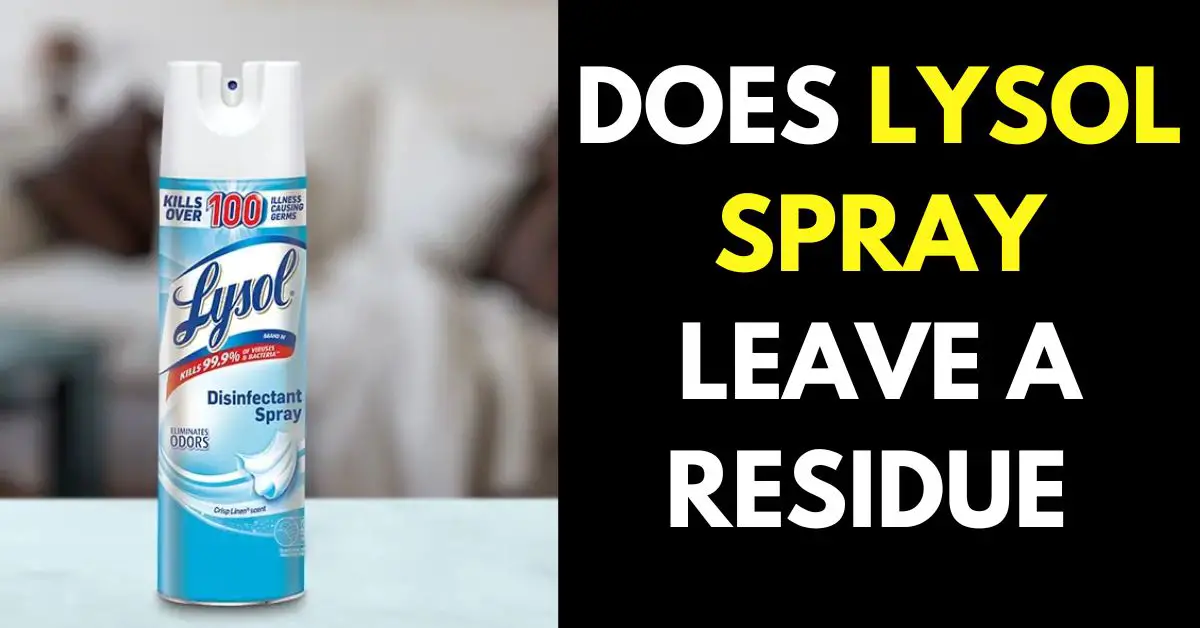
In light of recent events, we’ve all become more aware of the importance of keeping our homes and workplaces clean and sanitized. Lysol spray is a popular cleaning product that many people turn to in order to kill germs and disinfect surfaces. However, there are often questions and concerns about whether it leaves a residue or not.
We’ll dive deeper into this topic and explore the factors that can affect whether or not Lysol spray leaves a residue. So, let’s get started and find out the answer to this important question.
Does Lysol Spray Leave a Residue
Lysol spray may leave a residue depending on the surface it is sprayed on and how much spray is used. If you use too much spray or spray it too close to a surface, it may leave a visible residue.
Additionally, certain surfaces may be more prone to residue than others, such as wood or porous surfaces.
To minimize residue, it is important to follow the instructions on the Lysol spray can and use it as directed.
This may include holding the can at a certain distance from the surface and allowing the spray to fully dry before touching or wiping the surface.

Are You Supposed to Wipe Off Lysol Spray?
The answer to whether or not you should wipe off Lysol spray depends on the intended use and the surface being sprayed. Lysol spray is designed to disinfect and kill germs on surfaces, and the product label typically provides specific instructions for use.
In some cases, such as when using Lysol spray on food contact surfaces, it is important to follow the label instructions and wipe the surface with a clean, damp cloth after spraying to remove any residue.
This is to prevent the ingestion of harmful chemicals that may be present on the surface.
However, for other surfaces such as countertops, doorknobs, or light switches, it is not necessary to wipe off the Lysol spray after application.
In fact, wiping the surface immediately after spraying may reduce the effectiveness of the product, as it may not have enough time to kill the germs on the surface.
How Do You Remove Lysol Residue?
If you notice Lysol residue on a surface, you can remove it using a few simple steps:
Using Rubbing Alcohol
Using a lightly dampened cloth with rubbing alcohol can be an effective method for removing Lysol residue from surfaces. Here are the steps to follow:
- Mix rubbing alcohol and water in equal parts in a small bowl.
- Dip a soft, lint-free cloth in the solution and wring out the excess liquid. Make sure the cloth is only lightly dampened and not dripping wet.
- Gently wipe the affected area with a cloth, applying light pressure to remove the residue. Be sure to avoid rubbing too hard, as this can damage the surface.
- If needed, repeat the process with a fresh cloth until the residue is completely removed.
- Once the residue is removed, wipe the surface with a clean, damp cloth to remove any remaining alcohol solution.
- Dry the surface with a clean towel or let it air dry.
Using Vinegar and Baking Soda
Another effective method for removing Lysol residue from surfaces is to use a mixture of vinegar and baking soda. The combination of vinegar and baking soda creates a mild abrasive that helps to lift off the residue without damaging the surface.
Additionally, both vinegar and baking soda are safe, natural cleaning products that are effective at removing stains and odors. It’s important to test this method on a small, inconspicuous area first to ensure that it doesn’t damage or discolor the surface.
Here are the steps to follow:
- Mix 1/2 cup of white vinegar with 1/2 cup of warm water in a bowl.
- Sprinkle a small amount of baking soda onto the affected area.
- Dip a clean cloth into the vinegar solution and wring out the excess liquid.
- Gently scrub the surface with the damp cloth, using circular motions to lift off the residue.
- Rinse the surface with warm water to remove any remaining vinegar solution and baking soda.
- Dry the surface with a clean towel or let it air dry.
Does Lysol Spray Leave a Residue FAQs
Can I Spray Lysol on My Bed Sheets
Can I Spray Lysol in My Room
Make sure the room is well-ventilated by opening windows and doors or using a fan to circulate the air.
Hold the can of Lysol about 6-8 inches away from the surface you want to disinfect and spray until the surface is thoroughly wet.
Let the spray sit for the recommended time indicated on the label, which is usually 10 minutes.
After the recommended time, wipe the surface with a clean cloth or allow it to air dry.
Avoid spraying Lysol directly on fabrics or soft surfaces, as the residue can be difficult to remove and can cause skin irritation or allergic reactions.
Always wear gloves and avoid inhaling the spray mist while using Lysol.
